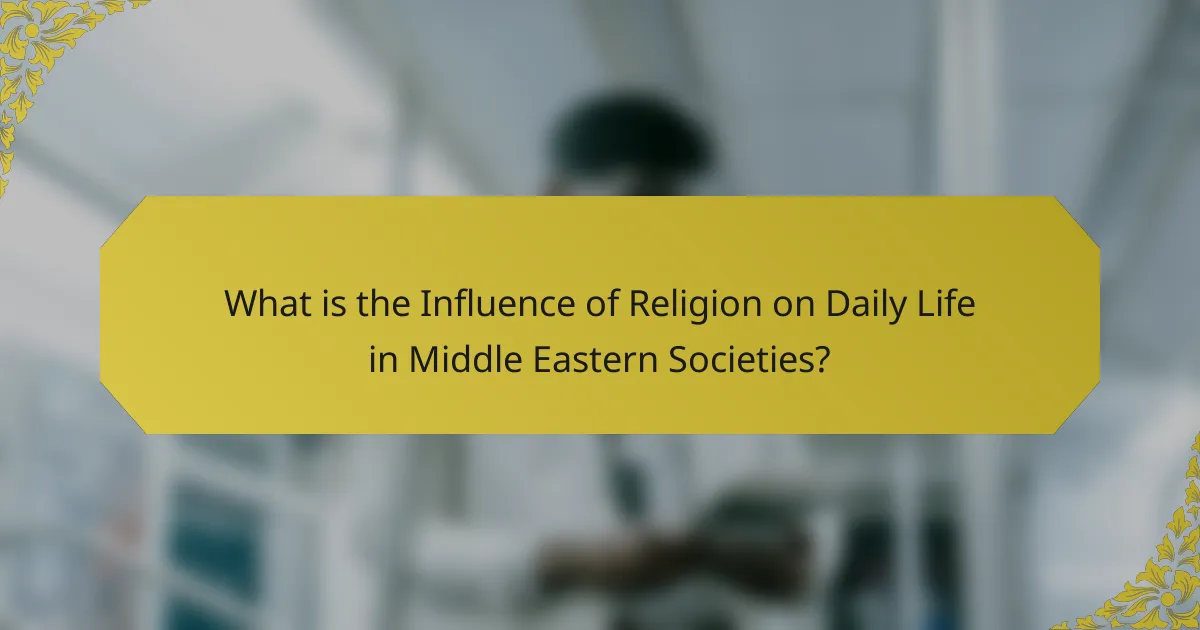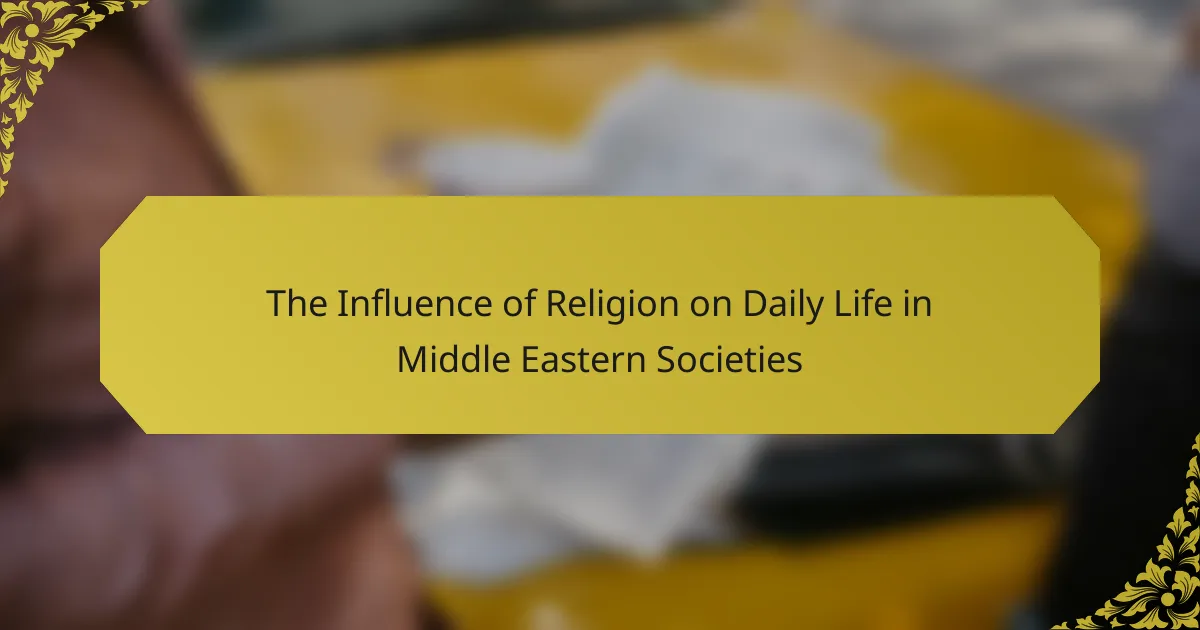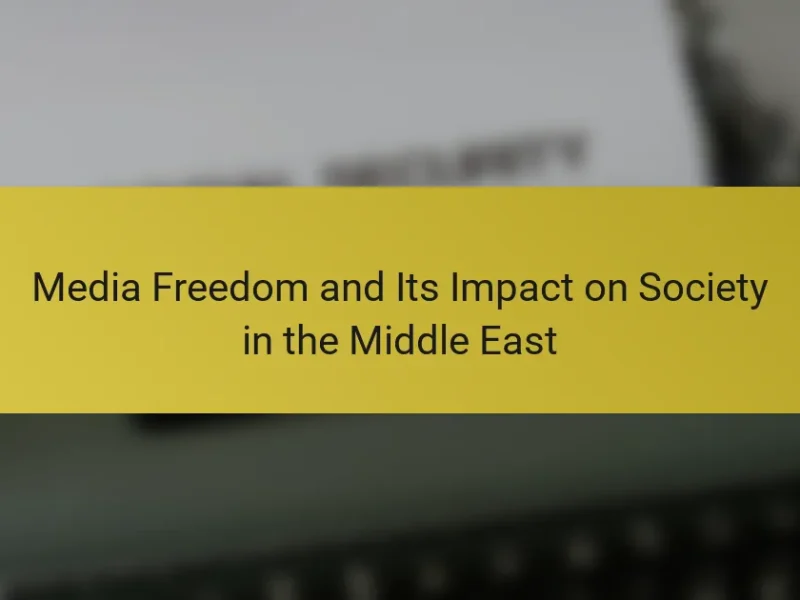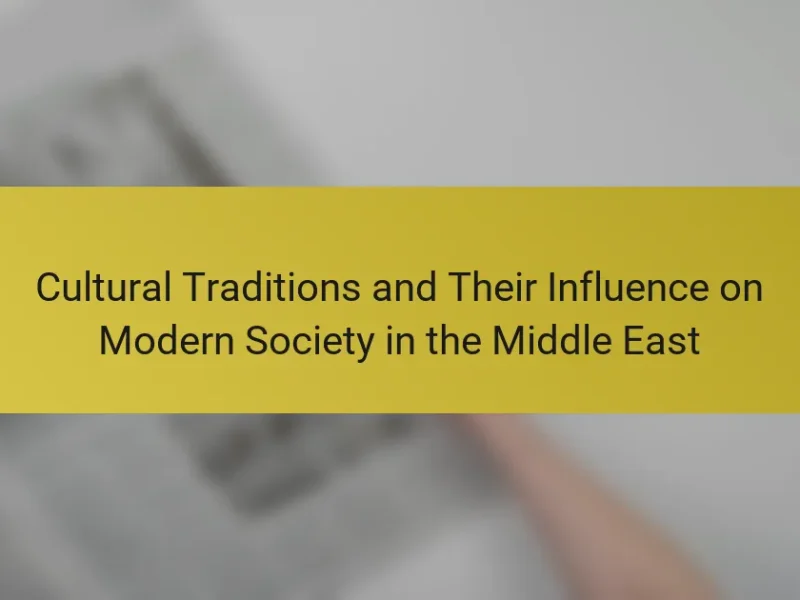
What is the Influence of Religion on Daily Life in Middle Eastern Societies?
Religion significantly influences daily life in Middle Eastern societies. It shapes cultural practices, social norms, and legal systems. Daily routines often include prayer and religious observances. For instance, Muslims pray five times a day, which structures their schedules. Religious holidays, such as Ramadan, affect work and social activities. Dietary laws, like halal, guide food consumption. Family and community gatherings often center around religious events. Additionally, religious leaders play crucial roles in community decision-making. This intertwining of faith and daily life reinforces social cohesion and identity within these societies.
How does religion shape cultural practices in these societies?
Religion significantly shapes cultural practices in Middle Eastern societies. It influences daily rituals, festivals, and community gatherings. Religious observances dictate dietary laws, such as halal practices in [censured]. These laws affect what is consumed and how food is prepared. Additionally, religious holidays, like Ramadan, foster communal activities and social bonding. Prayer rituals structure daily schedules and community interactions. The architecture of homes and public spaces often reflects religious significance. Religious teachings also guide moral values and social norms. Overall, religion serves as a foundational element that intertwines with various cultural aspects in these societies.
What are the key religious practices observed daily?
Key religious practices observed daily include prayer, fasting, and reading sacred texts. In [censured], Muslims perform five daily prayers called Salah. These prayers occur at specific times throughout the day. Fasting during Ramadan is a significant practice, where Muslims abstain from food and drink from dawn until sunset. Additionally, reading the Quran is encouraged daily for spiritual growth. These practices are integral to maintaining faith and community ties. They reflect the deep-rooted traditions in Middle Eastern societies, influencing daily routines and social interactions.
How do religious beliefs influence social interactions?
Religious beliefs significantly influence social interactions by shaping values, norms, and behaviors. These beliefs create a framework for how individuals relate to one another. For instance, in many Middle Eastern societies, shared religious practices foster community bonds. People often engage in communal prayers and celebrations, enhancing social cohesion. Additionally, religious teachings often promote values such as charity and hospitality. This encourages individuals to support one another, strengthening social ties. Studies show that religious affiliation can lead to increased trust among community members. In essence, religious beliefs serve as a guiding force in social dynamics, influencing both personal relationships and broader societal interactions.
Why is religion a central aspect of identity in Middle Eastern societies?
Religion is a central aspect of identity in Middle Eastern societies due to its deep historical roots and cultural significance. The majority of people in this region identify with major religions, primarily [censured], which shapes their values and social norms. Religious beliefs influence daily practices, community interactions, and family structures.
Additionally, religion often acts as a unifying force in diverse societies, providing a shared framework for understanding life and moral conduct. Historical events, such as the spread of [censured] in the 7th century, have further entrenched religious identity in the region.
Moreover, religious institutions play a critical role in governance and law, affecting political and social dynamics. For instance, Sharia law, derived from Islamic teachings, influences legal systems in several Middle Eastern countries.
The intertwining of religion with national identity is also evident in the way religious holidays and rituals are celebrated, reinforcing communal bonds. Overall, religion shapes not only personal identity but also collective identity across Middle Eastern societies.
In what ways does religion define personal and communal identity?
Religion shapes personal and communal identity through shared beliefs and practices. It provides individuals with a sense of purpose and belonging. Religious teachings often dictate moral values and social norms. These values influence personal decisions and behaviors. Communal identity is reinforced through rituals and traditions. Celebrations and gatherings foster a sense of unity among followers. Historical context shows that religious affiliation can influence social structures. For example, in many Middle Eastern societies, religion impacts family roles and community interactions.
How does religious affiliation affect political views?
Religious affiliation significantly affects political views. Individuals often align their political beliefs with the teachings and values of their faith. For example, in many Middle Eastern societies, Islamic teachings influence perspectives on governance and law. Data from the Pew Research Center indicates that religious beliefs shape opinions on issues like women’s rights and freedom of expression. Additionally, religious leaders can sway public opinion and political decisions through their influence. This connection between faith and politics is evident in electoral patterns, where religious groups often mobilize voters around shared values. Overall, religious affiliation plays a crucial role in shaping political ideologies and behaviors in these societies.
What role does religion play in family dynamics?
Religion significantly influences family dynamics in Middle Eastern societies. It shapes values, beliefs, and practices within families. Religious teachings often dictate roles and responsibilities among family members. For example, in many Muslim families, the father typically assumes the role of the primary provider. The mother often takes on caregiving and nurturing roles, reflecting traditional gender norms reinforced by religious texts.
Religious observances, such as prayer and fasting, also foster family unity. Families often engage in communal worship and rituals, strengthening their bonds. These practices promote shared values and a sense of belonging. Additionally, religion can guide family decision-making, from marriage choices to conflict resolution.
Studies show that families who actively practice their faith report higher levels of cohesion and support. Research from the Pew Research Center indicates that religious families tend to have stronger relationships and emotional well-being. Thus, religion plays a critical role in shaping the structure and interactions within families in Middle Eastern societies.
How do religious teachings impact family structures?
Religious teachings significantly shape family structures in Middle Eastern societies. They often dictate roles, responsibilities, and relationships within families. For instance, many religions emphasize patriarchal systems where men are seen as heads of households. This can lead to a division of labor, with men typically providing for the family and women managing the home.
Religious teachings also influence marriage practices, including the importance of arranged marriages in some cultures. These marriages are often viewed as alliances between families rather than just unions between individuals. Additionally, religious beliefs can dictate acceptable family sizes, often promoting larger families in certain communities.
Furthermore, teachings on morality and ethics can affect parenting styles and expectations. For example, many religious teachings stress the importance of obedience and respect for elders. This can create hierarchical family dynamics where children’s roles are clearly defined.
In summary, religious teachings play a crucial role in defining family structures, roles, and relationships in Middle Eastern societies.
What are the religious customs surrounding marriage and parenting?
Religious customs surrounding marriage and parenting vary significantly across different Middle Eastern societies. In many Islamic cultures, marriage is considered a sacred contract between families. The customs often include a formal proposal, known as “khitbah,” followed by a wedding ceremony called “nikah.” This ceremony typically includes reciting verses from the Quran and the signing of a marriage contract.
Parenting customs in these societies are deeply influenced by religious teachings. Parents are often encouraged to raise children with strong moral values based on religious principles. In [censured], for instance, there is an emphasis on teaching children about faith, prayer, and community responsibilities from a young age.
In Jewish communities, marriage customs may include a “ketubah,” a marriage contract outlining the husband’s responsibilities. Parenting emphasizes education, with a focus on Jewish traditions and religious observance.
Christian communities may also have unique customs, such as the sacrament of marriage, which is seen as a divine covenant. Parenting often involves baptism and religious education.
These customs are rooted in historical and cultural contexts, reflecting the diverse interpretations of religious texts and traditions across Middle Eastern societies.
How does religion influence education in Middle Eastern societies?
Religion significantly influences education in Middle Eastern societies. It shapes curricula, values, and teaching methods. Many schools incorporate religious teachings alongside secular subjects. Islamic principles often guide moral education and social behavior. In countries like Saudi Arabia, religious education is mandatory. This focus on religious instruction impacts student perspectives and community roles. Additionally, religious authorities may control educational institutions. This can affect academic freedom and curriculum choices. The intertwining of religion and education reflects cultural values and societal norms.
What is the role of religious institutions in education?
Religious institutions play a significant role in education by providing moral and ethical guidance. They often establish schools that integrate religious teachings with academic subjects. This integration promotes a holistic approach to education. Many religious institutions emphasize character development alongside intellectual growth. They also contribute to community cohesion by fostering shared values among students. In Middle Eastern societies, these institutions often influence cultural identity through educational programs. For example, Islamic schools focus on the Quran and religious studies as part of the curriculum. This educational model shapes the worldview of students within these communities.
How do religious values shape educational content and methods?
Religious values significantly shape educational content and methods in Middle Eastern societies. These values influence curriculum choices, emphasizing moral teachings and religious texts. Schools often integrate religious principles into daily lessons, reinforcing cultural identity. Teaching methods may prioritize rote memorization of religious texts, reflecting traditional approaches. Additionally, educators may incorporate religious holidays into the academic calendar, promoting community and cultural engagement. Studies show that religious beliefs can enhance student motivation and discipline in learning environments. Overall, the intertwining of religious values and education fosters a unique learning atmosphere aligned with cultural norms.
What are the economic implications of religious practices?
Religious practices have significant economic implications in societies, particularly in the Middle East. These implications manifest through various channels such as tourism, charitable giving, and labor market participation. For instance, religious tourism generates substantial revenue, with millions visiting sites like Mecca annually. This influx boosts local economies and creates jobs. Additionally, religious practices often encourage charitable giving, known as zakat in [censured], which redistributes wealth and supports community welfare. This financial support can enhance local businesses and services. Furthermore, religious observances can influence work schedules and economic productivity. Certain days are designated for worship, impacting labor availability. Overall, the intertwining of religion and economy shapes social structures and community development in Middle Eastern societies.
How does religion affect consumer behavior and business ethics?
Religion significantly influences consumer behavior and business ethics. In Middle Eastern societies, religious beliefs shape purchasing decisions and ethical standards. Consumers often prefer products that align with their faith. For example, halal food is essential for Muslim consumers. This preference drives businesses to ensure compliance with religious guidelines. Additionally, religious teachings can dictate ethical business practices. Honesty and integrity are emphasized in many faiths. Research shows that companies adhering to these principles often gain consumer trust. A study by the Pew Research Center indicates that 70% of Middle Eastern consumers consider ethical practices vital in their purchasing decisions. Thus, religion plays a crucial role in shaping both consumer behavior and business ethics in these societies.
What role does religion play in charitable practices and social welfare?
Religion significantly influences charitable practices and social welfare. Many religious teachings emphasize the importance of helping those in need. For instance, [censured] encourages zakat, a form of almsgiving, which mandates Muslims to donate a portion of their wealth to the less fortunate. This practice not only aids in poverty alleviation but also fosters community solidarity. [censured] also promotes charity through teachings like the parable of the Good Samaritan, urging followers to assist the marginalized. In Middle Eastern societies, religious institutions often lead social welfare initiatives. They provide essential services such as education, healthcare, and food distribution. Studies show that religious organizations are among the largest providers of social services in these regions. Thus, religion plays a crucial role in shaping charitable behaviors and enhancing social welfare systems.
How do religious festivals and observances impact community life?
Religious festivals and observances significantly enhance community life. They foster social cohesion among members. Shared rituals create a sense of belonging. These events often involve communal meals, reinforcing relationships. Festivals also provide economic benefits through local commerce. Increased tourism during these times boosts local businesses. Cultural traditions are preserved and passed down through generations. Additionally, religious observances often encourage charitable acts, promoting community support.
What are the major religious festivals celebrated in the region?
The major religious festivals celebrated in the Middle Eastern region include Eid al-Fitr, Eid al-Adha, and Ramadan. Eid al-Fitr marks the end of Ramadan, a month of fasting observed by Muslims. Eid al-Adha commemorates the willingness of Ibrahim to sacrifice his son in obedience to God. Ramadan is significant as it involves fasting from dawn to sunset. These festivals are characterized by communal prayers, feasting, and charitable giving. They play a crucial role in reinforcing community bonds and religious identity. In many countries, these festivals are public holidays, emphasizing their importance in daily life.
How do these festivals foster community cohesion?
Festivals foster community cohesion by bringing people together for shared cultural and religious experiences. These events encourage participation from diverse community members, strengthening social bonds. They create a sense of belonging and collective identity, which is vital in Middle Eastern societies. Festivals often involve communal activities such as feasting, music, and dance, promoting interaction among attendees. This interaction is essential for building trust and understanding within the community. Additionally, festivals often commemorate shared historical or religious narratives, reinforcing common values and beliefs. Studies show that such communal gatherings can enhance social networks, leading to increased support systems among community members.
How does the influence of religion manifest in art and literature?
Religion influences art and literature through themes, symbols, and narratives. In many works, religious beliefs shape characters’ motivations and moral dilemmas. Sacred texts often inspire literary masterpieces, such as Dante’s “Divine Comedy,” which reflects Christian theology. Visual art frequently depicts religious figures and events, evident in Renaissance paintings like Michelangelo’s “Creation of Adam.” The use of calligraphy in Islamic art illustrates reverence for the written word. Additionally, poetry often explores spiritual themes, as seen in Rumi’s works that blend mysticism and love. Overall, religion serves as a foundational element in the creative expressions of many cultures.
What themes are prevalent in religious art and literature?
Prevalent themes in religious art and literature include faith, morality, and [censured]. These themes often reflect the beliefs and values of specific religious traditions. For example, faith is depicted through narratives of divine intervention and miracles. Morality is illustrated via stories that convey ethical lessons and the consequences of actions. [censured] often manifests in the representation of the divine and the sacred. Additionally, themes of community and devotion are common, emphasizing the importance of collective worship and shared beliefs. Historical texts and artworks, such as the Quran and Islamic calligraphy, exemplify these themes. They serve to reinforce cultural identity and moral values within Middle Eastern societies.
How do religious narratives shape cultural storytelling?
Religious narratives significantly shape cultural storytelling by providing foundational themes and moral frameworks. These narratives often serve as a source of identity and community cohesion. They influence the values and beliefs reflected in stories shared within a culture. For example, Islamic teachings in the Middle East inspire tales that emphasize virtues like charity and compassion. This can be seen in folk stories where characters embody these ideals. Moreover, religious narratives often dictate the structure and content of storytelling traditions. They guide the portrayal of heroes, villains, and moral lessons. In many cases, these narratives are passed down through generations, ensuring continuity within the culture. As a result, cultural storytelling becomes a medium for preserving religious heritage and communal values.
What challenges arise from the intersection of religion and modernity?
The intersection of religion and modernity presents several challenges. One significant challenge is the conflict between traditional beliefs and contemporary values. Many religious communities struggle to reconcile their doctrines with modern concepts such as gender equality and individual rights.
This tension can lead to social fragmentation within communities. For instance, younger generations may embrace modernity, while older generations may resist change. This generational divide can create friction and hinder community cohesion.
Additionally, modernity often promotes secularism, which can marginalize religious practices. In some Middle Eastern societies, this marginalization can provoke backlash from religious groups.
Economic modernization may also challenge religious norms. As societies industrialize, traditional roles may shift, impacting family structures and community dynamics.
These challenges require careful navigation to maintain social harmony while respecting religious values.
How do secular movements interact with religious traditions?
Secular movements often challenge religious traditions by advocating for separation of religion from state affairs. They promote ideas such as individual rights and freedoms that may conflict with religious doctrines. For example, secular movements in Middle Eastern societies have pushed for gender equality and freedom of expression. This has led to tensions between secular advocates and conservative religious groups. In some cases, secular movements have resulted in social reforms, while in others, they face backlash and repression. Historical examples include the rise of secular nationalism in the 20th century, which sought to diminish the influence of religious authorities. These interactions shape the socio-political landscape in Middle Eastern societies.
What role does technology play in the evolution of religious practices?
Technology significantly influences the evolution of religious practices. It facilitates communication and access to religious texts. Digital platforms allow for virtual worship services, especially during crises like the COVID-19 pandemic. Social media enables the sharing of religious experiences and teachings globally. Online forums create communities for discussion and support among believers. Mobile applications provide tools for prayer, meditation, and scripture study. Technologies like live streaming enhance participation in religious events. Historical shifts, such as the printing press, previously transformed access to religious materials. These advancements indicate that technology continues to reshape how faith is practiced and experienced.
How can one navigate religious diversity in Middle Eastern societies?
To navigate religious diversity in Middle Eastern societies, one should prioritize understanding and respect. Engaging with local customs and traditions is essential. Learning about different religious practices fosters tolerance. Open dialogue with individuals from various faiths promotes mutual respect. Participating in interfaith events can enhance community cohesion. Awareness of regional historical contexts aids in navigating sensitivities. Establishing relationships based on trust encourages collaboration. Employing cultural sensitivity in communication is crucial for peaceful coexistence.
What are effective strategies for fostering interfaith dialogue?
Effective strategies for fostering interfaith dialogue include creating safe spaces for discussion. These spaces encourage open and respectful communication among different faiths. Establishing structured programs, such as interfaith workshops, can facilitate understanding of diverse beliefs. Engaging community leaders in dialogue promotes trust and collaboration. Shared community service projects can unite individuals from various faiths around common goals. Educational initiatives about different religions enhance awareness and reduce misconceptions. Hosting cultural events that celebrate diversity fosters appreciation for various traditions. Lastly, utilizing digital platforms can expand the reach of interfaith conversations to a broader audience.
How can understanding religious influences enhance cultural appreciation?
Understanding religious influences can significantly enhance cultural appreciation. Religion shapes values, traditions, and practices within cultures. In Middle Eastern societies, for instance, religious customs dictate social interactions and community events. Recognizing these influences allows individuals to engage more meaningfully with cultural expressions. For example, understanding Islamic practices can deepen appreciation for art, architecture, and literature in these societies. Additionally, knowledge of religious festivals can foster respect for diverse cultural practices. This understanding promotes empathy and reduces cultural misunderstandings. Ultimately, recognizing religious influences enriches the experience of cultural exploration and interaction.
The main entity of the article is the influence of religion on daily life in Middle Eastern societies. The article examines how religion shapes cultural practices, social norms, and legal systems, highlighting daily rituals such as prayer and fasting, and their impact on family dynamics, community interactions, and political views. It also explores the role of religious institutions in education and charitable practices, as well as the economic implications of religious observances. Additionally, the article addresses the challenges arising from the intersection of religion and modernity, emphasizing the importance of understanding religious diversity for fostering interfaith dialogue and cultural appreciation.


